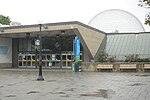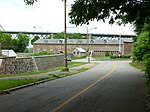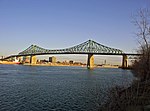Montreal Biosphere
1990 establishments in QuebecBuckminster FullerBuildings and structures completed in 1967Burned buildings and structures in CanadaEvent venues established in 1980 ... and 10 more
Expo 67Geodesic domesHigh-tech architectureLandmarks in MontrealMuseums established in 1990Museums in MontrealNatural history museums in QuebecParc Jean-DrapeauRebuilt buildings and structures in CanadaWorld's fair architecture in Montreal

The Biosphere, also known as the Montreal Biosphere, is a museum dedicated to the environment in Montreal, Quebec, Canada. It is housed in the former United States pavilion constructed for Expo 67 located within the grounds of Parc Jean-Drapeau on Saint Helen's Island. The museum's geodesic dome was designed by Buckminster Fuller.
Excerpt from the Wikipedia article Montreal Biosphere (License: CC BY-SA 3.0, Authors, Images).Montreal Biosphere
Rue des Seagulls, Montreal Ville-Marie
Geographical coordinates (GPS) Address Website External links Nearby Places Show on map
Geographical coordinates (GPS)
| Latitude | Longitude |
|---|---|
| N 45.514091666667 ° | E -73.531494444444 ° |
Address
Biosphère (La Biosphère de Montréal)
Rue des Seagulls
H3C 6A3 Montreal, Ville-Marie
Quebec, Canada
Open on Google Maps









